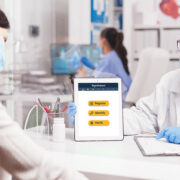Patient Safety and Communication are Critical as Patient Visits Return to Pre-pandemic Levels

COVID-19 has changed everything in unparalleled ways. Gone are the days when we could hang out casually with friends, be safe without PPE, and commute without the fear of catching the virus. It is quite natural that COVID-19 has impacted organizations and industries as well, and arguably, the US healthcare system is facing the worst consequences. The pandemic has affected every aspect of healthcare as we know it, and healthcare providers will be facing the consequences for years. They were forced to postpone elective procedures and outpatient visits to accommodate the surge of COVID-19 patients. While that was at the beginning of the year, many caregivers are now witnessing increased outpatient visits. Let’s take a look at some numbers regarding the fluctuation of outpatient visits, what caregivers should focus on now, and how patient safety and communication can be achieved with positive patient identification.

What has been the situation since the pandemic hit?
While the novel coronavirus has rattled almost every country’s healthcare system, America’s is the one it hit the worst. In addition to the many pre-existing issues with the healthcare system, the US has the highest number of COVID-19 cases in the world. In order to make room for the numerous COVID-19 cases, as already mentioned, caregivers had to cancel elective surgeries and also encourage non-critical patients to opt for telehealth visits.
Updates regarding outpatient visits
The Commonwealth Fund was closely following the updates of patient volumes within hospitals – let’s take a look at the numbers.
Outpatient visits took a significant hit – they had reduced by almost 60% during the early stages of the pandemic. The update provided by the Commonwealth Fund during May showed that patients were returning for outpatient visits, however, they were still one-third lower compared to pre-pandemic numbers. Also, the latest report shows that weekly outpatient visits are somewhat higher now, compared to the pre-pandemic period.
Outpatient visits vary
While this is a good sign for healthcare providers, it must be noted that these vary greatly depending on age, location, specialty, etc. For instance, in-person visits from younger patients are still lower than they were before the pandemic. Visits are higher for urologists, dermatologists, and adult PCPs, whereas behavioral health providers are experiencing lower visits. More Medicare patients are coming for inpatient visits compared to the pre-pandemic period. Telemedicine visits were higher when inpatient visits declined, but its usage is declining. However, its usage is still much higher than it was before the pandemic.

All these comparisons show that providers and patients are adapting to the new normal. Many patients are suffering from complex diseases and, due to the pandemic, they have been postponing healthcare visits for far too long. However, since restrictions are being lifted, patients are returning for outpatient visits in order to avail healthcare services. While providers are opening their doors to treat patients, they also need to ramp up their patient safety and communication efforts. After all, the post-pandemic world is completely new for everyone – there’s no tried and tested formula to ensure everyone’s safety. Healthcare providers also must make sure that their patients are not contracting COVID-19. Let’s see how this can be a possibility.
How patient safety and communication are hampered
All of the patients of any given hospital must first be identified. This happens either at the registration desks or within the emergency department. Different caregivers have different patient identity verification methods in place. Now, many caregivers either use inefficient methods, like questioning patients, or use solutions that have become outdated, such as contact-based patient identification platforms.
When asking patients questions, there are high chances that the registrar or nurse will identify the wrong medical record – they might need to find the record from an EHR system that contains thousands. Moreover, duplicate medical records are quite prevalent. Whatever the case may be, such inefficient methods hamper patient safety, lead to poor communication, and adversely impact patient outcomes.
While many used touch-based solutions to identify patients before the pandemic, COVID-19 has rendered these solutions unsatisfactory. Many caregivers have witnessed significantly lower utilization of these solutions – patients simply are reluctant to touch them. This is because of the pandemic and the fear of contracting the virus, which is not unreasonable. Every patient of any given hospital is processed from registration desks and EDs – can you imagine how disastrous it would be if one of them had COVID-19? Once the infected patient touches the device, it would lead to everyone else becoming infected. Before, infection control was a common headache of caregivers, and now it is a concern for patients too. Touch-based solutions have always had an impact on patient safety, but only the most forward-thinking caregivers foresaw this. That’s why they went with RightPatient, improving patient safety and communication in the process.
RightPatient enhances patient safety
RightPatient is the leading patient identification platform used by caregivers who prioritize patient safety. It’s an entirely touchless solution that uses a powerful photo-based engine and patients’ faces to identify them across the care continuum.
Whenever patients arrive at the hospital, all they need to do is look at the camera – the platform matches the saved photo taken during registration with the present one, ensuring an entirely touchless, hygienic, and safe experience for everyone involved. This eliminates the risk of contracting infectious diseases and enhances patient safety.
By identifying patients accurately right from appointment scheduling, as well as other touchpoints, RightPatient ensures patient data integrity by preventing data corruption, improving communication across the care continuum and reducing the chances of medical errors based on incorrect patient data.









Leave a Reply
Want to join the discussion?Feel free to contribute!